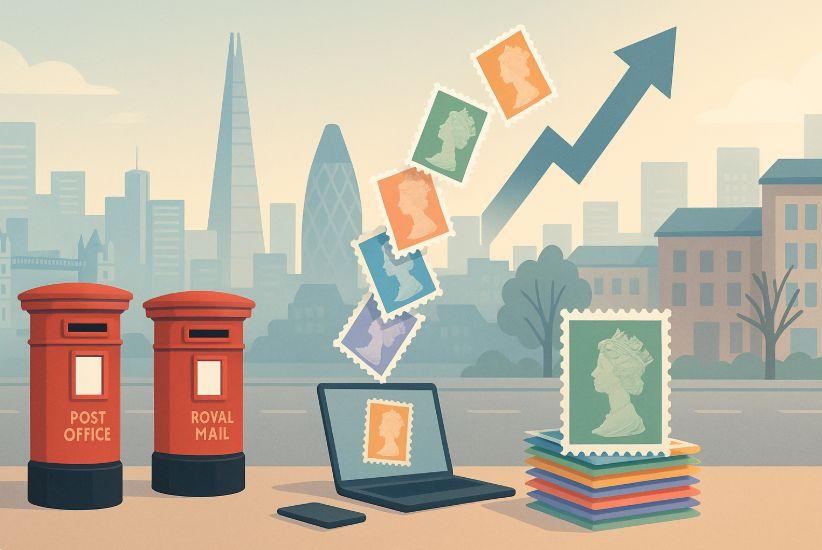Postal services are a lifeline for communication and commerce in the UK, even in an era dominated by digital messaging. Letters, greeting cards, and official documents still travel through the hands of Royal Mail, the country’s primary postal service.
Yet, over the years, sending a simple letter has become costlier, and 2025 has brought another postage stamp price increase that affects individuals and businesses alike.
This latest change has prompted conversations across London, where a large portion of the population relies on the postal service for personal and professional correspondence.
While a few pence per stamp may seem insignificant at first glance, these small increases compound over time especially for businesses that handle hundreds of letters each month. Understanding why prices are rising, how they impact consumers, and what strategies can reduce costs is crucial for anyone who relies on the UK postal system.
What Is the Current Postage Stamp Price in the UK?

As of August 2025, Royal Mail has implemented a new postage stamp price increase, affecting both first-class and second-class mail. These new prices reflect rising operational costs, including transport, staff wages, and energy expenses, while also helping Royal Mail sustain its nationwide delivery network despite declining letter volumes.
Current UK Postage Stamp Prices (2025)
The table below shows the updated rates for letters and small parcels:
| Mail Type | Weight Limit | 2025 Price |
| First-Class Letter | Up to 100g | £1.35 |
| Second-Class Letter | Up to 100g | £0.85 |
| First-Class Large Letter | Up to 100g | £2.05 |
| Second-Class Large Letter | Up to 100g | £1.65 |
| Small Parcel (2nd Class) | Up to 1kg | £3.69 |
| Small Parcel (1st Class) | Up to 1kg | £4.69 |
Key Insights for UK Mail Users
- First-class letters now cost £1.35, an increase from £1.25 in 2024.
- Second-class letters saw a steeper 13% rise, now at £0.85.
- Large letters and small parcels have also increased, impacting online sellers and small businesses.
- Prices are uniform across the UK, including London, meaning local residents pay the same as other regions.
For London-based households, sending occasional letters or greeting cards may only increase costs slightly. However, small businesses and eCommerce sellers that post frequently will feel a bigger financial impact over time.
Why Has Royal Mail Increased Postage Stamp Prices?
Operational Challenges and Rising Costs
Delivering millions of letters and parcels across the UK requires an extensive network of vehicles, staff, and sorting facilities. London alone hosts several major postal hubs that handle vast daily volumes.
Fuel prices, staff wages, and facility maintenance contribute to rising operational costs, prompting the need for postage stamp price increases to keep the service sustainable.
Decline in Letter Volumes
In the digital age, email, social media, and messaging apps have largely replaced traditional correspondence. According to Royal Mail, letter volumes have fallen by nearly 60% over the past decade. Maintaining the infrastructure to deliver fewer letters across the same nationwide network creates financial strain.
Inflation and Economic Pressures
The UK has faced continued inflation over the past few years. Price increases in energy, fuel, and logistics directly impact Royal Mail’s cost structure. A modest price increase in stamp costs helps offset these pressures without drastically reducing service coverage.
How Does the Postage Stamp Price Increase Affect UK Consumers and Businesses?
Impact on Individual Consumers
Londoners sending personal letters, greeting cards, or important documents will face higher costs. A household that sends 10 first-class letters monthly now spends £13.50 instead of £12.50, which over a year adds up to £12 more. While the difference may seem small, it contributes to the overall rising cost of living in urban areas like London.
Impact on Businesses and eCommerce Sellers
Small businesses, particularly online sellers and service providers, feel the price hike more intensely. For a business sending 200 second-class letters monthly, costs rise from £150 to £170, totaling an additional £240 per year.
Businesses with bulk mailing operations must either absorb these costs or pass them on to customers via higher shipping fees.
Effect on Charities and Non-Profits
Charities and community organisations that rely on mail for donations and awareness campaigns face budget pressures. For them, even small price changes may limit the number of letters they can send.
Are There Any Cheaper Alternatives for Sending Mail in the UK?

Digital Communication
In London’s fast-paced environment, many personal and professional interactions have moved online. Email newsletters, digital invitations, and e-signatures can replace some traditional letters. While digital channels are not suitable for official documentation or physical items, they offer zero-cost alternatives for certain communications.
Online Postage Services
Royal Mail’s Click & Drop platform allows users to purchase postage online, sometimes at slightly lower rates. Businesses can print labels, drop parcels at post offices, or schedule courier collections, saving both time and money.
Bulk Mailing and Business Discounts
Companies with regular mailing needs can open a Royal Mail Online Business Account (OBA) or use franking machines. These solutions offer discounts compared to standard stamp prices, making them ideal for London-based companies handling frequent deliveries.
What Can London Residents Do to Save on Postage Costs?
Stock Up Before Price Hikes
Purchasing stamps before official price changes allows users to lock in lower rates. Non-barcoded stamps can be exchanged for barcoded ones via Royal Mail’s free swap scheme, ensuring their continued validity.
Use Batch Mailing and Strategic Timing
Sending multiple letters together or scheduling non-urgent deliveries with second-class post reduces costs. London residents who plan ahead can optimize postage expenses.
Consider Hybrid Mail Solutions
Services like PostSnap or hybrid mail platforms allow users to upload documents online, which are then printed and posted by the service provider, often at reduced rates compared to traditional mailing.
How Often Does Royal Mail Increase Stamp Prices?
Royal Mail generally reviews postage prices annually, with most changes occurring in March or April.
Historical Stamp Price Trends
- 2019: First-class reached 70p
- 2021: Crossed 85p
- 2023: Reached £1.10
- 2025: Now £1.35
These gradual increases reflect Royal Mail’s need to offset declining mail volumes and rising costs.
Will the Postage Stamp Price Increase Affect UK Delivery Times?
While prices have risen, delivery targets remain the same.
Royal Mail’s Service Standards
- First-Class Mail: Aims for next working day delivery
- Second-Class Mail: Typically 2–3 working days
- Parcels and Tracked Mail: Variable depending on service
Price changes are designed to maintain service quality, not accelerate delivery. London residents can expect standard timelines to remain consistent unless wider operational challenges emerge.
How Does the Postage Stamp Price Increase Influence Online Shopping and Deliveries?
The UK’s thriving eCommerce sector, including countless London-based online stores and marketplaces like Etsy and eBay, relies heavily on Royal Mail for order fulfillment. Every change in postage rates affects how businesses price their products and shipping.
Impact on Small Online Retailers
Independent sellers often operate on thin margins. A 10p to 15p rise per letter or small parcel might appear minimal, but multiplied across hundreds of monthly shipments, it can reduce profitability significantly. These costs may be passed on to consumers through slightly higher shipping fees or product price adjustments.
Effect on Customer Expectations
Modern shoppers expect fast and affordable shipping, with many comparing costs before placing an order. Increased postal rates can discourage buyers if sellers are forced to raise postage charges. To maintain competitiveness, businesses may explore courier services like Evri or DPD, or offer free delivery with higher minimum order values to offset postal costs.
Adaptation Strategies for eCommerce
- Combine shipments to reduce per-package costs
- Offer local pick-up options to London customers
- Use Royal Mail Click & Drop to access discounted online postage rates
The overall message for online sellers is clear: strategic shipping management is essential to absorb the effect of rising stamp prices without losing customers.
Could the Postage Stamp Price Increase Push the UK Toward a Cashless, Digital-First Postal System?

The repeated postage stamp price increases highlight a broader shift in consumer behavior and postal service economics. As mailing costs rise, both individuals and businesses naturally seek digital alternatives that are faster and often free.
Shift to Digital Communication
Over the last decade, the UK has seen a surge in electronic communication replacing letters:
- E-bills and e-statements replacing paper bills
- Digital greeting cards instead of physical ones
- Email and cloud storage for legal and business documents
Rising postage costs accelerate this trend, with fewer letters and more reliance on the internet for day-to-day communication.
The Future of Physical Stamps
Some postal analysts predict that within the next 10–15 years, physical stamps may become less common, and hybrid or fully digital mail solutions will dominate. Royal Mail already encourages online postage purchases and barcoded stamps, signaling a gradual shift to a more digital-first postal system.
Impact on Traditional Mail Users
While digital-first solutions are efficient, not all segments of society are equally prepared for a full transition. Elderly residents and those without reliable internet access could be disadvantaged if mailing costs rise too much or if physical stamps become rare.
This ongoing evolution underlines that the latest price increase is not just a financial issue, but a sign of the postal system’s changing nature.
Conclusion
The postage stamp price increase in 2025 reflects the growing operational and economic pressures faced by Royal Mail. While the rise may seem minor individually, its impact on frequent mail users, businesses, and eCommerce sellers is significant.
For London residents and companies, the key to managing these changes lies in strategic mailing habits, digital adoption, and exploring cost-saving alternatives.
As stamp prices continue to rise, staying informed and proactive will help both individuals and businesses adapt efficiently to the evolving UK postal landscape.
FAQs
Why are UK postage prices rising so quickly?
Falling letter volumes and rising operational costs, combined with inflation, force Royal Mail to increase stamp prices to maintain services.
Are stamp prices the same across the UK or different in London?
Postage stamp prices are uniform nationwide, so London residents pay the same rates as the rest of the UK.
Will older stamps still be valid after the price hike?
Yes, both barcoded and properly swapped stamps remain valid even after the price increase.
How can businesses manage rising mailing costs?
They can switch to bulk mailing, franking machines, and online postage discounts to reduce expenses.
Does the price increase apply to international mail?
Yes, although international postage rates vary by destination and weight.
Can digital franking save money for frequent mailers?
Absolutely. Franking offers lower rates than standard stamps and is ideal for businesses with regular mailing needs.
When is the next Royal Mail price review expected?
Historically, price reviews happen annually, with the next potential increase likely in early 2026.









Leave feedback about this